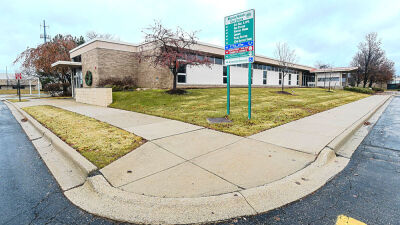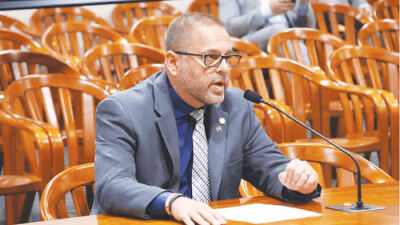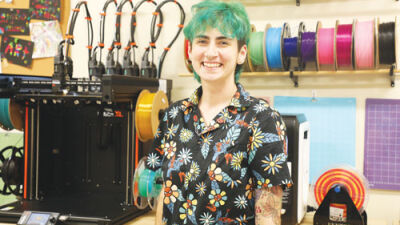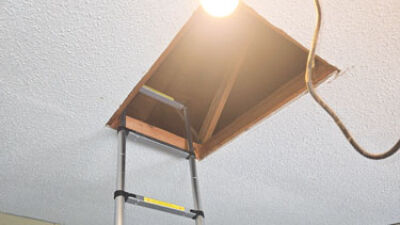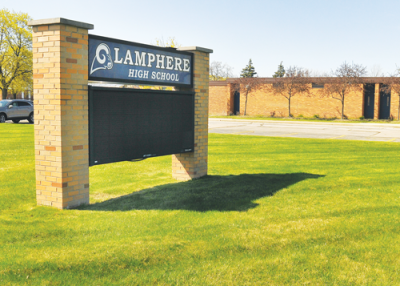
A view of Lamphere High School in the Lamphere Public Schools April 22. On May 6, voters in the district will decide whether to increase their taxes for 30 years to fund a variety of improvements at the schools. Voters can also vote early at the Royal Oak Senior Center.
Photo by Liz Carnegie
MADISON HEIGHTS — On May 6, voters in the Lamphere Schools will decide whether to raise their taxes by hundreds of dollars each year to fund an auxiliary gym, fine arts studio, robotics lab, roofing, security, theater upgrades and more.
If approved, the owner of a home with a market value of $200,000 and a taxable value of $100,000 will see their annual taxes increase by $415, starting with the bill this summer. The bond is for 4.15 mills each year for 30 years, generating $85 million.
Officials say the bond will greatly enhance the quality of the schools, while critics say it will place an unfair burden on homeowners already strained by inflation and stagnant wages.
Jake Priehs recently bought a home in the district. He described the sticker shock of the jump in taxes after his house was assessed. He also worries for those in more vulnerable situations.
“We’re already taxed to death over here,” Priehs said. “There are seniors on fixed incomes. People about to retire, watching their 401k lose value. Wages aren’t keeping up. And there could be a recession soon. $85 million is just too much.”
The special election May 6 is being funded by the Lamphere Schools. The bond is the only local issue on the ballot.
“While I do not have the final cost for the election yet, with the added cost of early voting, I estimate the cost of the election to be approximately $35,000,” said Cheryl Rottmann, the city clerk, via email. “Lamphere is responsible for the full cost, since this is a special election that was requested by the district.”
It should be noted that the number of mills are estimated, and variables such as interest rates can change the number of mills actually required to retire a bond, making it difficult to compare bonds across districts.
Lamphere Superintendent Dale Steen previously told the Madison-Park News that the district has been “extremely fiscally responsible with the taxpayers’ money.” The last bond was in 1997 for $35 million, and was paid off seven years early.
The district currently has a separate 3-mill sinking fund in place, renewed in 2017 for a period of 10 years, which will be up for renewal again in 2028. The sinking fund pays for smaller projects that Steen said can’t be used for bond projects.
Steen said the district identified more than $150 million worth of projects that were then narrowed down to “high-priority items” totaling $85 million. These include more security cameras, secure entry points and safety glass to slow down intruders.
Parking lots would be redone at each school to improve traffic flow, reduce congestion and streamline drop-off and pickup times. The bond would also replace rooftops and upgrade mechanical systems for heating and cooling, improving energy efficiency.
Other projects include the conversion of Lamphere High School’s shop area into a 3D art studio for the fine arts program; the creation of a robotics learning lab at Page Middle School that would be used by students districtwide, with a completion date in the spring or summer of 2027; upgrades to the auditorium stage, dressing rooms and technology at the high school; replacing worn-out playground equipment at each elementary school; enhancing the music and art classrooms at all grade levels, including new music equipment; and new furniture, storage and equipment for STEM classrooms at the elementary schools.
Topping it all off is the construction of a new auxiliary gymnasium at Lamphere High, which the superintendent says is necessary since more space is needed for the athletics program. There would be renovations at existing gyms at both the middle school and high school, as well, including the middle school locker rooms. Synthetic turf would also be added to the baseball and softball infields.
The projects would be prioritized based on factors such as safety, security and infrastructure. Steen anticipates most items would be completed in a span of six to seven years.
“The only other new construction besides the auxiliary gym are the secured entryways to the school buildings,” Steen clarified in a recent email. “The main entryways will be built out to have visitors routed through the main office before getting access to the rest of the building. This is very similar to other districts who have used bonds for security purposes.
“The needs will not go away (without this bond),” he added. “The school district will continue to use the sinking fund for small-scale improvements. Major replacements or updates may require the school district to use operational revenue.”
Stephanie Sawicki, a resident in the Lamphere district, said she feels the district has done “an exceptional job” providing a good value to taxpayers while maintaining its facilities and other assets. She believes the ongoing investment is worth it.
“Due to the age of our facilities, we’re at a point where without a bond, emergency repairs may have to be paid out of our operating budget, taking resources directly away from students and staff,” Sawicki said in an email. “This isn’t about luxury. It’s about stability and keeping Lamphere strong for the next generation. People move here for a reason, families choose Lamphere, and we need to honor that by continuing to invest in the schools that brought us here in the first place.”
Priehs said he likes parts of the bond, such as the roofing and security, but he would like the district to come back with smaller bond proposals that voters could consider piecemeal.
“Do they really need a new art studio right now? A new gym? Maybe they can scale this back a bit and break it into smaller bonds,” Priehs said. “That way, people can choose and budget around it.”
Will Weaver is another homeowner in the Lamphere district.
“My concern is that the property taxes in the Lamphere district are already excessively high,” Weaver said. “It’s irresponsible to run a bond this big at this time with the economy being what it is, and the property taxes already being so excessively high.
“They’re going to end up causing people to fall into such a bad situation,” Weaver continued. “Not only with their principal, interest and taxes, but they’re going to cause people to become deficient in their escrows with their mortgage companies, at a time when they’re already behind the eight ball.”
Residents in precincts 5 through 9 will be able to vote on May 6 from 7 a.m. to 8 p.m. One can also vote early beginning Saturday, April 26 at the Royal Oak Senior Center, 3500 Marais Ave. in Royal Oak, from 8:30 a.m. to 4:30 p.m. daily through May 4, except for May 1 when the hours are noon to 8 p.m.
The following is the language of the Lamphere Schools bond proposal, as it will appear on the ballot when residents vote May 6:
Shall The Lamphere Schools, County of Oakland, State of Michigan, borrow the sum of not to exceed Eighty-Five Million Dollars ($85,000,000) and issue its general obligation unlimited tax bonds, in one or more series, to pay the cost of the following projects to create a modern learning environment for students and for health, safety, security, energy, conservation and other purposes:
• Remodeling, equipping, re-equipping, furnishing, re-furnishing school buildings, playgrounds, athletic fields and other facilities;
• Erecting and completing secure entryway additions at school buildings, a gymnasium addition at the high school and additions to other facilities;
• Acquiring and installing instructional technology infrastructure and equipment for the robotics program at the middle school building; and
• Preparing, developing and improving sites at school buildings, playgrounds, athletic fields and other facilities?
The maximum number of years any series of bonds may be outstanding, exclusive of refunding, is not more than thirty (30) years; the estimated millage that will be levied to pay the proposed bonds in the first year is 4.15 mills (which is equal to $4.15 per $1,000 of taxable value); and the estimated simple average annual millage that will be required to retire each series of bonds is 3.81 mills annually ($3.81 per $1,000 of taxable value).
If approved by the voters, the bonds will be guaranteed by the State under the School Bond Qualification and Loan Program (the “Program”). The School District currently has $0 of qualified bonds outstanding and $0 of qualified loans outstanding under the Program. The School District does not expect to borrow from the Program to pay debt service on these bonds.
The estimated computed millage rate required to be levied to pay the proposed bonds may change in the future based on changes in certain circumstances.
(Pursuant to State law, expenditure of bond proceeds must be audited, and the proceeds cannot be used for teacher, administrator or employee salaries, repair or maintenance costs or other operating expenses.)
 Publication select ▼
Publication select ▼
